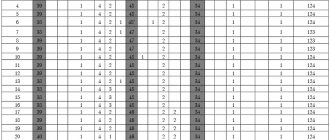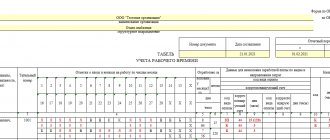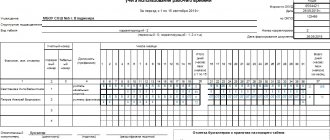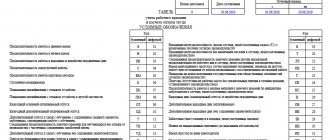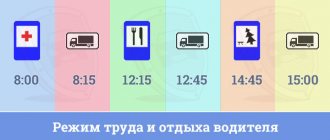What codes to use
Employers are offered a choice of alphabetic or numeric codes to register a particular event. For example, attendance has the letter I or 01 in digital terms, and DO in the time sheet is leave without pay (in digital terms 16).
You will find the necessary codes in the table, and their complete list is contained on the first page of the T-12 form.
| Code | ||
| alphabetic | digital | |
| Duration of work during the day | I | 01 |
| Duration of work at night | N | 02 |
| Duration of work on weekends and non-working holidays | RV | 03 |
| Overtime duration | WITH | 04 |
| Duration of work on a rotational basis | VM | 05 |
| Business trip | TO | 06 |
| Off-the-job training | PC | 07 |
| Advanced training with a break from work in another area | PM | 08 |
| Annual basic paid leave | FROM | 09 |
| Annual additional paid leave | OD | 10 |
| Additional leave in connection with training while maintaining average earnings for employees combining work with training | U | 11 |
| Reduced working hours for on-the-job trainees with partial pay retention | UV | 12 |
| Additional leave in connection with training without pay | UD | 13 |
| Maternity leave (in connection with the adoption of a newborn child) | R | 14 |
| Parental leave until the child reaches the age of three | coolant | 15 |
| Unpaid leave granted to an employee with the permission of the employer | BEFORE | 16 |
| Leave without pay under the conditions provided for by the current legislation of the Russian Federation | OZ | 17 |
| Additional annual leave without pay | DB | 18 |
| Temporary disability (except for cases provided for by code “T”) with the assignment of benefits in accordance with the law | B | 19 |
| Temporary disability without benefits in cases provided for by law | T | 20 |
| Reduced working hours versus normal working hours in cases provided for by law | Champions League | 21 |
| Time of forced absence in the event of dismissal, transfer to another job or suspension from work being declared illegal, with reinstatement to the previous job | PV | 22 |
| Absenteeism while performing state or public duties in accordance with the law | G | 23 |
| Absenteeism (absence from the workplace without good reason for the time established by law) | ETC | 24 |
| Duration of part-time work at the initiative of the employer in cases provided for by law | NS | 25 |
| Weekends (weekly vacation) and non-working holidays | IN | 26 |
| Additional days off (paid) | OB | 27 |
| Additional days off (without pay) | NV | 28 |
| Strike (under conditions and in the manner prescribed by law) | ZB | 29 |
| Absences for unknown reasons (until the circumstances are clarified) | NN | 30 |
| Downtime caused by the employer | RP | 31 |
| Downtime due to reasons beyond the control of the employer and employee | NP | 32 |
| Downtime due to employee fault | VP | 33 |
| Removal from work (non-admission) with payment (benefits) in accordance with the law | BUT | 34 |
| Removal from work (non-admission) for reasons provided for by law, without accrual of wages | NB | 35 |
| Time of suspension of work in case of delay in payment of wages | NZ | 36 |
Let us note that the unified form T-12 has the right to be used by any organization, regardless of its form of ownership, except for budgetary institutions. Personnel officers of these companies should use the codes in the work time sheet in 2022, which are described in the order of the Ministry of Finance of Russia dated March 30, 2015 No. 52n (form according to OKUD 0504421), otherwise this will be recognized as a violation of the requirements.
For budgetary institutions (hospitals, clinics, kindergartens and schools, others), the table of symbols in the time sheet in 2022 is as follows:
| Indicator name | Code |
| Weekends and non-working holidays | IN |
| Night shifts | N |
| Carrying out government duties | G |
| Regular and additional holidays | ABOUT |
| Temporary disability, disability due to pregnancy and childbirth | B |
| Holiday to care for the child | OR |
| Overtime work | WITH |
| Absenteeism | P |
| Absences for unknown reasons (until the circumstances are clarified) | NN |
| Absences with permission from the administration | A |
| Study weekend | VU |
| Additional study leave | OU |
| Work on weekends and non-working holidays | RP |
| Actual hours worked | F |
| Business trips | TO |
We will show an example of filling out the T-12 form (partially) to demonstrate how the report card indicates leave without pay, attendance, absenteeism and other events.
Meaning of letters
In accounting practice, there are common cases of errors that occur when filling out time sheets. They are often associated with incorrect placement of symbols. To avoid mistakes in the process of filling out the timesheet, you must adhere to the following recommendations.
- I (01) – opening hours (distinguish between daytime and evening). To enter data, you can rely on the security check marks. In this case, the head of a separate department must confirm the presence of employees.
- N (02) – work at night. To enter information, the marks of the access service are also taken into account. The boss confirms presence at work.
- РВ (03) – work of employees on holidays. In the process of entering data, pay attention to the security or checkpoint marks. The management team confirms that the subordinate is at the workplace.
- From (04) – hours of overtime work. An order must be drawn up addressed to the manager regarding the need and approval of work beyond the norm. The document on overtime work is signed by the employee and confirmed by the access service.
- K (06) – business trip. An order regarding the need for field work is drawn up, which is signed by the employee. At the same time, sometimes they issue a certificate and assignment for sending on official assignments. A report is drawn up upon arrival.
- OT (09) – annual paid rest (basic). The HR department is entrusted with the function of drawing up an order with the signature of the employee himself.
- OD (10) – additional paid rest, which is provided for by current legislation (regulations or collective agreement). It is necessary to draw up an order with the signature of the employee himself.
- U (11) – leave for training with continued salary. It can be issued for advanced training, with a break from the production process, etc. It is issued on the basis of a drawn up leave order, referral to advanced training courses, etc.
- HC (12) – shortened working hours (relevant for on-the-job training employees). At the same time, it is possible to partially retain wages.
- UD (13) – provision of additional leave due to training without pay. An order is drawn up and signed by the employee.
- P (14) – maternity leave. An order is drawn up, which is signed by the employee himself.
- OL (15) – parental leave (partially paid). The HR department draws up an order and is signed by the employee himself.
- DO (16) – leave without pay, provided in accordance with the permission of the employer. An order is drawn up and signed by the employee himself.
- OZ (17) – unpaid leave (without saving salary). An order is drawn up and signed by the employee himself.
- B (19) – temporary disability (not counting cases provided for by code “T”). This symbol also denotes leave to care for a sick person and due to quarantine. In all cases, certificates of incapacity for work must be issued.
- T (20) – disability that is not paid. It can be represented by a domestic injury, the need to care for a sick person, etc.
- LCH (21) – hours of labor reduction for workers and employees. It is necessary to ensure that there is an order from the head of the organization.
- RP (31) or NP (32) – downtime is not the fault of the employee. An order is drawn up from the head of the organization.
- G (23) – absenteeism while maintaining salary. It is necessary to draw up an order from the head of the organization.
- PR (24) – absenteeism, which is a failure to appear at the workplace for at least 4 working hours continuously. This category also includes administrative arrest, being in a sobering-up station, pseudo-strikes, etc. The mark is affixed on the basis of submitted memos from department heads, explanatory notes from employees, acts of commissions, etc.
- NS (25) – hours worked during part-time work at the initiative of the employer. Marks in the report card are made on the basis of extracts from the employment contract, orders, etc.
- In (26) – days off. Those established at the legislative level are taken into account.
- ZB (29) – strikes. A mark is made based on documentation that confirms the legality of the event.
- NN (30) – absences for unknown reasons. However, there is no documentation that can explain the reasons for the employee’s absence.
the letter designations in the time sheet have important legal significance . Since the law only gives guidance on them, for convenience in work they can be changed, combined, and also come up with your own letter designations in the time sheet .
In what cases is the NN code used?
The absence of an employee for unknown reasons - this is a transcript of the NN in the report card - is entered each time and as long as the employee is absent from the workplace, and the person in charge does not have documents about the reasons for his absence. Even if the manager of the absent employee swears that the employee is absenteeism (the designation of absenteeism in the time sheet is PR or 24), then do not rush to put this code in the primary accounting documents. Wait for the person to bring a document explaining the absence. Otherwise, a time sheet with an incorrect code will be provided to the accounting department, and then it will turn out that the employee was absent for a good reason. You will have to make changes to primary accounting documents, recalculate wages, and do extra work.
Answer
Two designations in the “I/RV” timesheet can be used when part of the shift falls on a regular (non-holiday) day, and part of the shift falls on a holiday. Below you indicate the actual time worked by the employee.
For example, such a designation may be applied when the shift is from 8 a.m. on May 9 (a holiday) to 8 a.m. on May 10 (a regular day), with the total duration of the shift being 24 hours.
Indicate the hours worked on this shift with the code “I”, while separately highlighting the hours worked on a holiday with the code “RV”.
It will turn out - “I / RV”, and below 24/16 (24 is the total duration of the shift, of which 16 are work on a holiday).
Another option is possible . You can indicate 8/16 on the timesheet (i.e. 8 hours – work on a regular day and 16 hours – work on a holiday). It is important that this designation is clear to the payroll accountant.
If the shift falls only on a holiday, then only “RW” and the actual time worked are used.
For example, May 9 from 8 to 20. We indicate “RV” and the actual time worked - 12.
Note. Risks for the employer are possible not for the “extra/double” mark on the timesheet, but in the event that the timesheet incorrectly reflects non-working holidays, as a result of which the employee’s salary is incorrectly calculated.
In particular:
- administrative liability under Parts 1, 2 of Art. 5.27 Code of Administrative Offenses of the Russian Federation. For example, if you do not indicate work on a non-working holiday in your timesheet, regulatory authorities may regard this as improper recording of working time and a violation of Part 4 of Art. 91 Labor Code of the Russian Federation;
- incorrect payment for work on a non-working holiday if you incorrectly reflect it on the timesheet. And this may entail, in particular, the risk of a legal dispute with the employee.
Are days off marked on the timesheet when an employee is sick?
When an employee is on sick leave, code B (temporary disability) is assigned for the entire period of temporary disability, including weekends and holidays.
Read more: how sick leave is paid on weekends.
A similar complete registration is carried out when employees are on maternity leave (P) or child care when they reach the age of three (decoding OZ in the report card) and unpaid leave (DO code).
What are the rules for placing letter designations in a time sheet?
In addition to the approved unified forms, Goskomstat Resolution No. 1 also contains explanations for filling them out, which can be used if problems arise with the execution of a particular form.
According to these clarifications, the timesheet indicates the time actually worked/unworked by each employee of the organization. To do this, opposite the last name of each employee, certain letter designations are placed for each day of the month (including weekends and holidays), under which the number of hours is indicated (if it is possible or necessary to count the time spent by the employee at work). In this case, the employer, at his discretion, can choose any of the methods of marking the timesheet:
- or by the complete registration method, when attendance/absence and all other deviations are noted;
- or by recording only deviations (no-shows, lateness, overtime, business trips, etc.).
The method of recording only deviations can be used if the length of the employee’s working day is constant and is established in the employment contract or internal regulations. If the duration of an employee’s shift is a variable value, the working time sheet must be filled out using the continuous registration method. This will allow you to identify possible processing.
Deviations from attendance noted in the report card must be confirmed by properly executed documents. For example, an employee going on vacation is carried out on the basis of a corresponding order, and in this case, the time sheet indicates exactly those days that are indicated in the order. The same applies to business trips, sick leave and absenteeism. The accounting department reviews additional documents justifying the entries in the time sheet, and only if the data in them matches the corresponding salary calculation.
How are days off on vacation designated?
If, when an employee is on annual basic paid leave (PA) or on annual additional paid leave (AP), a public holiday falls during the period of his rest, then in the report card the OT or OD code must be replaced with B (weekends and non-working holidays), because, on the basis of Article 120 of the Labor Code of the Russian Federation, non-working holidays falling during the period of paid rest are not included in the number of calendar days of vacation.
Filling out a timesheet when an employee is on maternity leave
If an employee works part-time and is caring for a child, we recommend the following.
The letter code “I” or the numeric “01” designate the days of work, and “OJ” and “15”, respectively, the time for child care. Under the line with the codes in the timesheet, you must enter the working time.
We also recommend indicating the time for feeding the child on the timesheet. Breaks to feed the child are included in working hours and paid for (Part 4 of Article 91, Part 4 of Article 258 of the Labor Code of the Russian Federation). There are no approved codes for such breaks. Therefore, you can approve yours if necessary.
Part-time working hours are established for an employee only if he asked for it in the application.
How to celebrate holidays with pay due to coronavirus quarantine
These days are not days off in the strict sense of the word, and marking them with code B or the digital equivalent 26 is incorrect. It is advisable to introduce a new designation for this period, for example NOD - non-working paid days, and record this in your accounting personnel policy. If employees work during this period, they are assigned code I or 01.
This rule applies in case of declared non-working days at both the federal and regional levels. If a decision is made to declare downtime for reasons beyond the control of the parties to the employment contract, we put code NP or 32 in the timesheet. Or another option: RP in the timesheet is downtime due to the fault of the employer (or digital code 31), if Due to the pandemic and the employer, there are temporarily no classes for staff.
More details: payment for downtime.
How to celebrate vacation
If an employee is sent on vacation, then the corresponding days in the working time sheet are marked with special codes. In this case, the bottom cell - the number of hours - is not filled in.
To reflect leave in forms No. T-12 and No. T-13, the following designations are used: OT (09) - for the main annual paid leave, OD (10) - for additional paid leave provided to some employees (for example, employees with irregular hours; Article 116 of the Labor Code of the Russian Federation). Study leave corresponds to code U (11), and leave “at your own expense” corresponds to code DO (16).
To indicate maternity leave, code P (14) is used. The same code is used in the case of extended leave granted due to complicated childbirth (Article 255 of the Labor Code of the Russian Federation). To reflect parental leave for a child up to three years old, the OZh code (15) is used.
IMPORTANT. For the purpose of filling out the report card, there is no difference between parental leave for a child up to 1.5 years and parental leave for a child up to 3 years. In any of these cases, the coolant code (15) is set for all days of the corresponding vacation.
Work with electronic sick leave according to new rules
Which form of report card is more convenient to use for filling out?
The form of the report card does not matter, if you like it, then use the form approved by Decree of the State Statistics Committee of Russia dated 01/05/2004 No. 1 (forms T-12, form T-13), or use the form approved by order of the Ministry of Finance of Russia dated 03/30/2015 No. 52n.
Commercial organizations have the right to develop and approve their own form of time sheets, determine what the code in the time sheet means, and decide which designations to use - alphabetic or digital. Nobody prohibits this, the main thing is that records are actually kept.
ConsultantPlus experts discussed how to reflect the period of an employee’s medical examination in a time sheet. Use these instructions for free.
What to do if there is no symbol in the report card?
If the unified form used does not contain a suitable code, the company has the right to create and approve the necessary codes independently. For example, to designate breaks for breastfeeding guaranteed by Art. 258 of the Labor Code of the Russian Federation, you can enter the conditional code “KG”.
If a company uses an independently developed form, then the coding of designations in the time sheet can be absolutely anything.
For an example of a time sheet developed by the company independently, see the article “Sample of filling out a time sheet.”
The designations in the working time sheet are recorded using a continuous recording method for each worker, or only deviations are displayed.
Let's consider the algorithm for filling out a time sheet.
Who is responsible for recording working hours?
If the organization is small, then one person can keep time records. If the structure of the enterprise is significant, then it is advisable to appoint a responsible person in each division.
All responsible persons, regardless of their number, are appointed by orders for the main activities in order to avoid various kinds of misunderstandings.
Responsibility for the completeness and correctness of filling out the timesheet lies with the person authorized by the order.
The head of the department is responsible for the timely submission of timesheets to the accounting department.
The employer is responsible for everyone.
How to properly keep track of working hours if the enterprise is small and the operating hours are five days a week
There is no single approach to record keeping: it is allowed to register (put down codes) all facts or record only deviations (temporary disability, absence for unknown reasons, etc.). The main criterion is the correctness of recording the actual time worked on paper, since this document is the primary one for calculating wages.
The first option is more convenient for cumulative accounting of working periods, the second is preferable when the duration of working hours is constant, as is the case with a five-day period.
In any case, working hours are recorded daily and submitted to the accounting department monthly.


